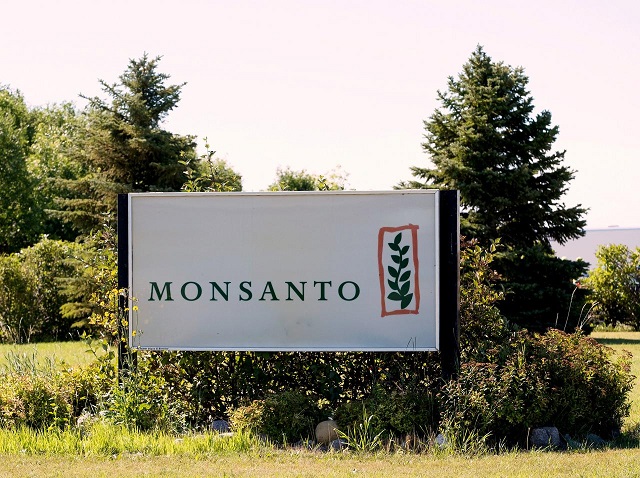
Monsanto had readied new genetically modified soybeans seeds. They were engineered for use with a powerful new weed-killer that contained a chemical called dicamba but aimed to control the substance’s main shortcoming: a tendency to drift into neighboring farmers’ fields and kill vegetation.
The company had to choose whether to immediately start selling the seeds or wait for the US Environmental Protection Agency (EPA) to sign off on the safety of the companion herbicide. The firm stood to lose a lot of money by waiting.
Because Monsanto had bred the dicamba-resistant trait into its entire stock of soybeans, the only alternative would have been “to not sell a single soybean in the United States” that year, Monsanto Vice President of Global Strategy Scott Partridge told Reuters in an interview. Betting on a quick approval, Monsanto sold the seeds, and farmers planted a million acres of the genetically modified soybeans in 2016.
But the EPA’s deliberations on the weed-killer dragged on for another 11 months because of concerns about dicamba’s historical drift problems. That delay left farmers who bought the seeds with no matching herbicide and three bad alternatives: Hire workers to pull weeds; use the less-effective herbicide glyphosate; or illegally spray an older version of dicamba at the risk of damage to nearby farms.
Monsanto challenged in Brazil
The resulting rash of illegal spraying that year damaged 42,000 acres of crops in Missouri, among the hardest hit areas, as well as swaths of crops in nine other states, according to an August 2016 advisory from the EPA. The damage this year has covered 3.6 million acres in 25 states, according to Kevin Bradley, a University of Missouri weed scientist who has tracked dicamba damage reports and produced estimates cited by the EPA.
The episode highlights a hole in a US regulatory system that has separate agencies approving genetically modified seeds and their matching herbicides. Monsanto has blamed farmers for the illegal spraying and argued it could not have foreseen that the disjointed approval process would set off a crop-damage crisis.
But a Reuters review of regulatory records and interviews with crop scientists shows that Monsanto was repeatedly warned by crop scientists, starting as far back as 2011, of the dangers of releasing a dicamba-resistant seed without an accompanying herbicide designed to reduce drift to nearby farms. In 2015, just before Monsanto released its soybeans seeds, Arkansas regulators notified the firm of damage from illegal spraying of its dicamba-resistant cotton seeds.
Some cotton farmers chose to illegally spray old versions of dicamba because other herbicides approved for use on the seeds were far less effective. The EPA did not approve the new dicamba formulation that Monsanto now sells for use with cotton and soybean seeds - XtendiMax with Vapor Grip - until after the 2016 growing season.
Monsanto’s Partridge acknowledged that the company misjudged the regulatory timeline for approval of its new herbicide. “The EPA process was lengthier than usual,” Partridge said. Monsanto, however, denies culpability for the crisis that followed the two-stage approval.
“The illegal misuse of old dicamba herbicides with Xtend seeds was not foreseeable,” the company’s attorneys said in a response to one class action suit filed by farmers in Missouri. “Even if it were foreseeable that farmers would illegally apply old dicamba to their Xtend crops, which it was not, Monsanto is not liable for harms caused by other manufacturers’ products.”
Monsanto's Partridge said in a written statement that the reports of damage from illegal spraying of dicamba on its cotton seeds in 2015 were “extremely isolated.” “Those who applied dicamba illegally should be held responsible,” Partridge said.
Monsanto’s handling of the delayed herbicide approval may cause the firm legal and public relations damage, but it has boosted the company’s business considerably. Instead of halting seed sales while waiting on herbicide approval, Monsanto captured a quarter of the nation's massive soybean market by the start of 2017, according to the US Department of Agriculture.
Even the damage from dicamba may have boosted sales. Some farmers whose crops were harmed said in interviews that they bought Monsanto’s new dicamba-resistant seeds as a defense against drift from nearby spraying.
State regulators believe the illegal spraying of dicamba-tolerant cotton and soybean crops continued in 2017 - after the EPA approved Monsanto's new herbicide. Farmers would still benefit from using old versions of dicamba because it is cheaper than XtendiMax.
Many growers also have dicamba on hand because it is legal to use for limited purposes. Regulators have not yet determined, however, how much damage came from illegal spraying and how much came from the legal application of XtendiMax, which weed scientists say still vaporizes under certain conditions.
Monsanto concedes that XtendiMax has caused crop damage, but blames farmers who the company says did not properly follow directions for applying the herbicide. The EPA, after delaying a decision on XtendiMax, gave the herbicide a limited two-year approval - as opposed to the standard 20 years - in case drift issues arose.
A US Department of Agriculture spokesman, Rick Corker, acknowledged in a statement to Reuters that the release of an engineered seed before its companion herbicide caused problems. The department, he said, is now in talks with the EPA about whether to coordinate approvals of paired seeds and chemicals.
“USDA and EPA are in discussions regarding the timing of our deregulations,” Corker said in a statement. The EPA did not comment on whether it planned any policy changes in response to the dicamba crisis.
EU delays decision on herbicide glyphosate
Early Warnings
Dicamba is cheap, plentiful, and has been used as a weed killer for decades. But its tendency to damage nearby fields had caused US regulators to limit its use to the task of clearing fields before planting or after harvest, when there are no crops to damage and cooler temperatures make it less likely the substance will migrate.
Farmers who illegally sprayed dicamba during growing season are now facing fines of up to $1,000 for each violation of EPA rules limiting the use of dicamba, which are enforced by state regulators. Farmers with damaged crops have filed at least seven lawsuits - five class-action suits and two by individuals - seeking compensation from Monsanto.
The suits claim the company should have known that releasing the seeds without a paired herbicide would cause problems. Monsanto officials had been repeatedly warned of the potential for damage from illegal spraying of dicamba on seeds designed to resist the chemical.
In October 2011, five scientists from Ohio State University addressed a conference in Columbus focused on the future of dicamba. In attendance were agriculture researchers from across the country as well as representatives of the companies Monsanto, Dow Chemical and BASF.
According to Douglas Doohan, one of the conference's organizers, three Monsanto employees, including Industry Affairs Director Douglas Rushing, attended the meeting. Monsanto had a keen interest in the topic because the company was far along in developing its new line of dicamba products at the time.
In their introduction to the symposium, Doohan and his colleagues outlined what they called an increased risk of illegal dicamba spraying by farmers once dicamba-resistant seeds became available. They also argued that dicamba-resistant seeds - and the illegal spraying that might accompany them - would lead farmers whose crops were damaged to buy their own dicamba-tolerant seeds to protect themselves from further drift, according to conference records.
Monsanto's Rushing gave his own presentation about dicamba to the symposium, according to conference records. Rushing explained the need for a new herbicide-and-seed combination to replace those that had grown less effective as weeds become more tolerant to certain chemicals, according to slides outlining Rushing’s conference presentation. He raised the issue of damage from dicamba drift, but said the risks could be reduced by using certain kinds of sprayers and taking other precautions.
Rushing could not be reached for comment. Monsanto did not directly respond to questions about the symposium.

1725783822-0/Tribune-Pic-(15)1725783822-0-165x106.webp)















COMMENTS
Comments are moderated and generally will be posted if they are on-topic and not abusive.
For more information, please see our Comments FAQ